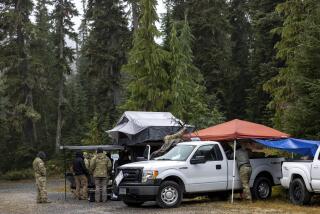AF Says Women Flew Grenada Missions
- Share via
Although federal laws bar women from combat duty, several female pilots, flight engineers and loadmasters flew missions to Grenada during the initial phases of the 1983 invasion, senior Air Force officials have told The Times.
The women, believed to have included personnel from the 63rd Military Airlift Wing based at Norton Air Force Base near San Bernardino, landed on the Caribbean island aboard C-141 troop transports while U.S. paratroopers were still fighting Cuban forces at Point Salines Airport.
“There was some hostile fire, but not in the immediate vicinity,” Maj. Gen. William J. Mall, who commanded the first wave of aircraft to attack Grenada, said Friday. “There was some (gunfire) at one end of the airport. . . . There was some risk there, that’s true.”
No aircraft was hit, Mall said, nor were any crew members killed or wounded during the airlifting of troops and supplies to and from an airport that was “under friendly control . . . although it was a combat zone.”
Mall said that he believes the use of women--one officer estimated that two dozen were present--did not violate the law or Air Force regulations.
Sources within the Air Force’s Military Airlift Command said that the women were deployed as an expedient. Invasion planning was so swift that there was no time to handpick crews for the aircraft used in the airlift, one source said.
“We alerted them (aircraft and crews) wherever they happened to be in the world at that time, diverted them to Pope (Air Force Base in North Carolina) and staged from there to Grenada,” he added. “To have excluded an aircraft from the mission simply because there was a woman on board would have lessened our response and reduced our effectiveness.”
U.S. Rangers and Marines, the vanguard of an armed force that eventually would number 6,000 troops, invaded Grenada at 5:40 a.m. on Oct. 25, 1983. The Point Salines Airport was declared secured by 7:15 a.m.
One officer attached to the operation said that women air crews from McGuire Air Force Base in New Jersey flew into Grenada during the first hours of the invasion. A male pilot estimated that more than two dozen women were involved in the operation.
Under 1956 provisions of U.S. Code 10-8549, female members of the Air Force “may not be assigned to duty in aircraft engaged in combat missions.”
Mall, former commander of the 23rd Air Force and now director of Air Force personnel planning at the Pentagon, said that commanders on Grenada knew that C-141 StarLifter transports with women crew members would be arriving.
“It was known that . . . we had some women crew members on those 141s, and we looked at the situation and determined that the risk of exposure to hostile fire and the risk of capture were not factors to preclude it,” Mall said. “It wasn’t something that surprised everyone.”
The use of women in combat has been a sensitive public issue since the late 1970s, when the military services and their academies opened their ranks wider to women. While women are legally barred from combat, integration of the services has placed them in planning and operational positions critical to war efforts.
The Grenada operation--mounted against what President Reagan described as “a Soviet-Cuban colony being readied as a major military bastion”--took place six days after the assassination of pro-Cuban Prime Minister Maurice Bishop and the overthrow of his government. An estimated 25 Cubans, 45 Grenadians and 18 American GIs were killed in the fighting.
More to Read
Sign up for Essential California
The most important California stories and recommendations in your inbox every morning.
You may occasionally receive promotional content from the Los Angeles Times.










